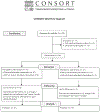Intraoperative goal-directed hemodynamic management in free tissue transfer for head and neck cancer
- PMID: 26829494
- PMCID: PMC7179726
- DOI: 10.1002/hed.24362
Intraoperative goal-directed hemodynamic management in free tissue transfer for head and neck cancer
Abstract
Background: The purpose of this study was to determine the effect of algorithmic physiologic management on patients undergoing head and neck free tissue transfer and reconstruction.
Methods: Ninety-four adult patients were randomized to treatment and control groups. The blood pressure of the control group was managed consistent with contemporary standards. The treatment group was managed using an algorithm based on blood pressure and calculated physiologic values derived from arterial waveform analysis. Primary outcome was intensive care unit (ICU) length of stay.
Results: ICU length of stay was decreased in the treatment group (33.7 vs 58.3 hours; p = .026). The complication rate was not increased in the treatment group.
Conclusion: The goal-directed hemodynamic management algorithm decreased the ICU length of stay. Judicious use of vasoactive drugs and goal-directed fluid administration has a role in improving perioperative outcomes for patients undergoing head and neck free tissue transfer. © 2016 Wiley Periodicals, Inc. Head Neck 38: E1974-E1980, 2016.
Keywords: critical care; free tissue transfer; goal-directed therapy; hemodynamics; length of stay.
© 2016 Wiley Periodicals, Inc.
Figures



Similar articles
-
Vascularized tissue transfer in head and neck surgery: Is intensive care unit-based management necessary?Laryngoscope. 2016 Jan;126(1):73-9. doi: 10.1002/lary.25608. Epub 2015 Sep 7. Laryngoscope. 2016. PMID: 26343412
-
Effect of goal-directed haemodynamic therapy in free flap reconstruction for head and neck cancer.Acta Anaesthesiol Scand. 2018 Aug;62(7):903-914. doi: 10.1111/aas.13100. Epub 2018 Mar 25. Acta Anaesthesiol Scand. 2018. PMID: 29574681 Clinical Trial.
-
Head and neck free flap reconstruction in patients older than 80 years.J Reconstr Microsurg. 2014 Oct;30(8):523-30. doi: 10.1055/s-0034-1384664. Epub 2014 Jul 15. J Reconstr Microsurg. 2014. PMID: 25025506
-
Perioperative care of head and neck free flap patients.Curr Opin Otolaryngol Head Neck Surg. 2017 Oct;25(5):405-410. doi: 10.1097/MOO.0000000000000384. Curr Opin Otolaryngol Head Neck Surg. 2017. PMID: 28604404 Review.
-
Postoperative care in ICU versus non-ICU after head and neck free-flap surgery: a systematic review and meta-analysis.BMJ Open. 2022 Jan 6;12(1):e053667. doi: 10.1136/bmjopen-2021-053667. BMJ Open. 2022. PMID: 34992114 Free PMC article.
Cited by
-
Intraoperative vasopressors in head and neck free flap reconstruction.Microsurgery. 2021 Jan;41(1):5-13. doi: 10.1002/micr.30677. Epub 2020 Nov 10. Microsurgery. 2021. PMID: 33170969 Free PMC article. Clinical Trial.
-
Effects of perioperative goal-directed fluid therapy combined with the application of alpha-1 adrenergic agonists on postoperative outcomes: a systematic review and meta-analysis.BMC Anesthesiol. 2018 Aug 17;18(1):113. doi: 10.1186/s12871-018-0564-y. BMC Anesthesiol. 2018. PMID: 30119644 Free PMC article.
-
Perioperative restrictive versus goal-directed fluid therapy for adults undergoing major non-cardiac surgery.Cochrane Database Syst Rev. 2019 Dec 12;12(12):CD012767. doi: 10.1002/14651858.CD012767.pub2. Cochrane Database Syst Rev. 2019. PMID: 31829446 Free PMC article.
-
Restricted Versus Liberal Versus Goal-Directed Fluid Therapy for Non-vascular Abdominal Surgery: A Network Meta-Analysis and Systematic Review.Cureus. 2023 Apr 28;15(4):e38238. doi: 10.7759/cureus.38238. eCollection 2023 Apr. Cureus. 2023. PMID: 37261162 Free PMC article. Review.
-
Perioperative predictors of early surgical revision and flap-related complications after microvascular free tissue transfer in head and neck reconstructions: a retrospective observational series.Clin Oral Investig. 2021 Sep;25(9):5541-5550. doi: 10.1007/s00784-021-03864-1. Epub 2021 Mar 8. Clin Oral Investig. 2021. PMID: 33686470 Free PMC article.
References
-
- Smith RB, Sniezek JC, Weed DT, Wax MK, Microvascular Surgery Subcommittee of American Academy of Otolaryngology–Head and Neck Surgery. Utilization of free tissue transfer in head and neck surgery. Otolaryngol Head Neck Surg 2007;137:182–191. - PubMed
-
- Serletti JM, Moran SL. Free versus the pedicled TRAM flap: a cost comparison and outcome analysis. Plast Reconstr Surg 1997;100:1418–1424; discussion 1425–1427. - PubMed
-
- Heinz TR, Cowper PA, Levin LS. Microsurgery costs and outcome. Plast Reconstr Surg 1999;104:89–96. - PubMed
-
- Suh JD, Sercarz JA, Abemayor E, et al. Analysis of outcome and complications in 400 cases of microvascular head and neck reconstruction. Arch Otolaryngol Head Neck Surg 2004;130:962–966. - PubMed
-
- Godden DR, Little R, Weston A, Greenstein A, Woodwards RT. Catecholamine sensitivity in the rat femoral artery after microvascular anastomosis. Microsurgery 2000;20:217–220. - PubMed
Publication types
MeSH terms
Grants and funding
LinkOut - more resources
Full Text Sources
Other Literature Sources
Medical

